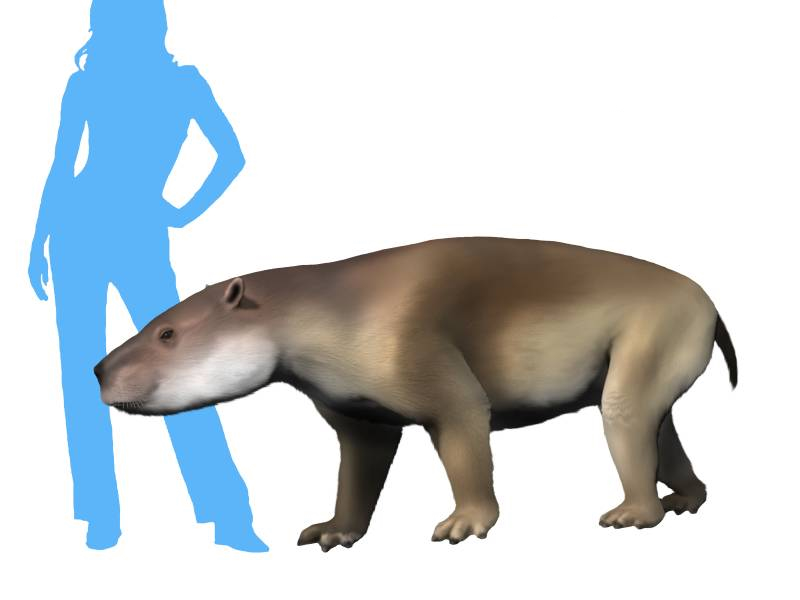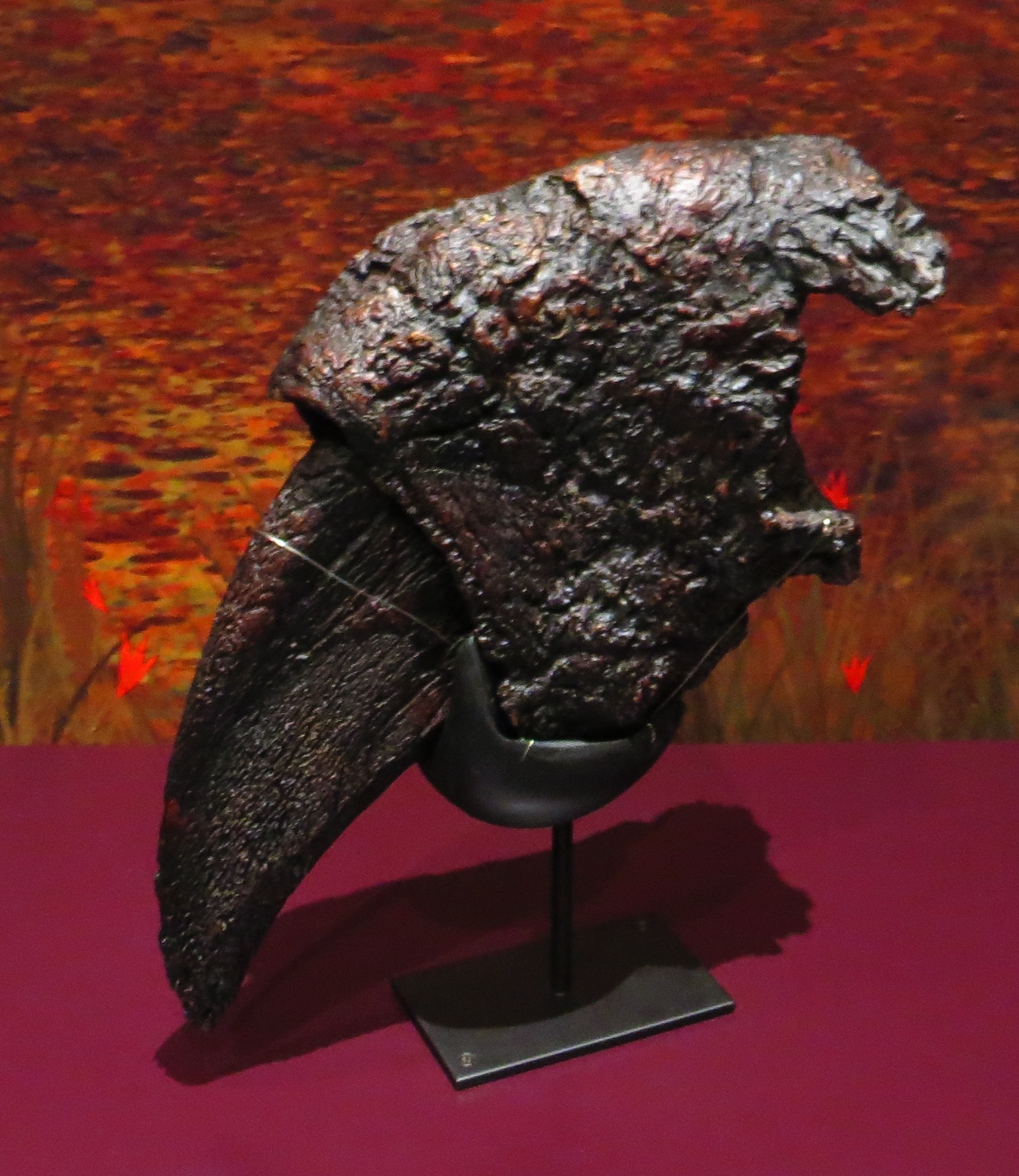|
Xenungulates
Xenungulata ("strange ungulates") is an order of extinct and primitive South American hoofed mammals that lived from the Late Paleocene to Early Eocene (Itaboraian to Casamayoran in the SALMA classification). Fossils of the order are known from deposits in Brazil, Argentina, Peru, and Colombia. The best known member of this enigmatic order is the genus '' Carodnia'', a tapir-like and -sized animal with a gait similar to living African elephants. Description Xenungulates are characterized by bilophodont M1–2 and M1–2, similar to pyrotheres, and complex lophate third molars, similar to uintatheres. Though other relationships, to arctocyonids for example, have been suggested, no proofs thereof have been found. The foot bones of xenungulates were short and robust and their digits terminated in broad, flat, and unfissured hoof-like unguals, quite unlike any other meridiungulates. The discovery of ''Etayoa'' in Colombia made it clear that xenungulates are distinct from ... [...More Info...] [...Related Items...] OR: [Wikipedia] [Google] [Baidu] |
Rodcania
''Rodcania'' is an extinct genus of mammal, belonging to the order Xenungulata. It contains a single species, ''Rodcania kakan'', which lived during the Paleocene. Its remains were found in South America. The genus name is an anagram of '' Carodnia''. Description This animal is only known from scarce fossil remains, and its appearance is therefore only conjectural. From a comparison with its relative '' Carodnia'', it is supposed that ''Rodcania'' was a rather heavy animal with a massive build and strong legs. An adult ''Rodcania'' could weigh around 165 kilograms. ''Rodcania'' is only known from a fragmentary left mandible, bearing the second and third molars. Both teeth are characterized by a thick layer of enamel, vertically oriented Hunter-Schreger bands, and distally inclined dental wear marks. ''Rodcania'' differs from its similar relative ''Carodnia'' and other xenungulates by the simplified and mesiodistally short trigonid of the third molar, the absence of paraconi ... [...More Info...] [...Related Items...] OR: [Wikipedia] [Google] [Baidu] |
Pyrotheria
Pyrotheria is an order of extinct meridiungulate mammals. These mastodon-like ungulates include the genera ''Baguatherium'', ''Carolozittelia'', ''Colombitherium'', ''Griphodon'', ''Propyrotherium'', ''Proticia'', and ''Pyrotherium''. They had the appearance of large, digitigrade, tapir-like mammals with relatively short, slender limbs and five-toed feet with broad, flat phalanges. Their fossils are restricted to Paleocene through Oligocene deposits of Brazil, Peru and Argentina. Some experts place the clade Xenungulata (which contains several genera, including ''Carodnia'') within Pyrotheria, even when dentition, although bilophodont in both orders, is very different. For most scholars, the two orders remain separated. The dentition is complete with strong, procumbent, chisel-shaped incisors, strong sharp-pointed canines, and low-crowned cheek teeth with bilophodont molars. The affinities of the Xenungulata remain uncertain. Affinities with the Dinocerata are strongly supporte ... [...More Info...] [...Related Items...] OR: [Wikipedia] [Google] [Baidu] |
Carodnia
''Carodnia'' is an extinct genus of South American ungulate known from the Early Eocene of Brazil, Argentina, and Peru. ''Carodnia'' is placed in the order ''Xenungulata'' together with ''Etayoa'' and '' Notoetayoa''. ''Carodnia'' is the largest mammal known from the Eocene of South America. It was heavily built and had large canines and cheek teeth with a crested pattern like the uintatheres to which it can be related. In life, it would have been a tapir-sized animal. It bore strong resemblances to dinoceratans, although without tusks or ossicones. Description Simpson noted that ''Carodnia'' resembles the primitive uintathere '' Probathyopsis''. Although Paula Couto also made the same favorable comparison, he placed ''Carodnia'' in the new order Xenungulata. concluded that ''Probathyopsis'' shares several dental characteristics with ''Carodnia'', but that in the latter the anterior dentition of is more reduced, the second lower and upper premolars are enlarged and pointe ... [...More Info...] [...Related Items...] OR: [Wikipedia] [Google] [Baidu] |
Meridiungulata
South American native ungulates, commonly abbreviated as SANUs, are extinct ungulate-like mammals of controversial affinities that were indigenous to South America prior to the Great American Biotic Interchange. They comprise five major groups conventionally ranked as orders—Astrapotheria, Litopterna, Notoungulata, Pyrotheria, and Xenungulata—as well as some other taxa, such as Didolodontidae and Kollpaniidae. It has been proposed that some or all of the members of this group form a clade, named Meridiungulata, though the relationships of South American ungulates remain largely unresolved. The two largest groups of South American ungulates, the notoungulates and the litopterns, were the only groups to persist beyond the mid Miocene. Only a few of the largest species of notoungulates and litopterns survived until the end-Pleistocene extinctions. Though most SANUs lived in South America, astrapotheres and litopterns are known from Eocene aged deposits in the Antarctic Peninsu ... [...More Info...] [...Related Items...] OR: [Wikipedia] [Google] [Baidu] |
Late Paleocene
The Thanetian is, in the International Commission on Stratigraphy, ICS Geologic timescale, the latest age (geology), age or uppermost stage (stratigraphy), stratigraphic stage of the Paleocene epoch (geology), Epoch or series (stratigraphy), Series. It spans the time between . The Thanetian is preceded by the Selandian Age and followed by the Ypresian Age (part of the Eocene). The Thanetian is sometimes referred to as the Late Paleocene. Stratigraphic definition The Thanetian was established by Switzerland, Swiss geologist Eugène Renevier in 1873. The Thanetian is named after the Thanet Formation, the oldest Cenozoic deposit of the London Basin, which was first identified in the area of Kent (southern England) known as the Isle of Thanet. The base of the Thanetian Stage is laid at the base of magnetic chronozone C26n. The references profile (Global Boundary Stratotype Section and Point) is in the Zumaia section (43° 18'N, 2° 16'W) at the beach of Itzurun, Pais Vasco, northern ... [...More Info...] [...Related Items...] OR: [Wikipedia] [Google] [Baidu] |
Arctocyonidae
Arctocyonidae (from Greek ''arktos'' ''kyôn'', "bear/dog-like") has been defined as an extinct family of unspecialized, primitive mammals with more than 20 genera. Animals assigned to this family were most abundant during the Paleocene, but extant from the late Cretaceous to the early Eocene (). Like most early mammals, their actual relationships are very difficult to resolve. No Paleocene fossil has been unambiguously assigned to any living order of placental mammals, and many genera resemble each other: generalized robust, not very agile animals with long tails and all-purpose chewing teeth, living in warm closed-canopy forests with many niches left vacant by the K-T extinction. Arctocyonids were early defined as a family of creodonts (early predators), then reassigned to the condylarths (primitive plant-eaters, now understood as a wastebasket taxon). More recently, these animals have been thought to be the ancestors of the orders Mesonychia and Cetartiodactyla, although some ... [...More Info...] [...Related Items...] OR: [Wikipedia] [Google] [Baidu] |
Uintatheriidae
Uintatheriidae is a family of extinct ungulate mammals that includes ''Uintatherium''. Uintatheres belong to the order Dinocerata, one of several extinct orders of primitive hoofed mammals that are sometimes united in the Condylarthra. Uintatheres were the largest land animals of their time, surviving from the late Paleocene into the Uintan Epoch of the Middle Eocene. They were heavy animals, with thick legs, massive bones, broad feet, and tiny brains. The most distinctive feature of the great majority of species, however, was the presence of multiple blunt "horns", perhaps similar to the ossicones of modern giraffes, and the presence of large, sabre-like canine teeth. They were eventually replaced as large browsing animals by the even larger brontotheres. Genera Family Uintatheriidae * Subfamily Uintatheriinae ** Genus ''Bathyopsis'' ** Genus ''Eobasileus'' ** Genus ''Prodinoceras'' ** Genus ''Tetheopsis'' ** Genus ''Uintatherium'' * Subfamily Gobiatheriinae ** Genus ''Gobiathe ... [...More Info...] [...Related Items...] OR: [Wikipedia] [Google] [Baidu] |
Astrapotheriidae
Astrapotheriidae is an extinct family of herbivorous South American land mammals that lived from the Late Eocene (Mustersan SALMA) to the Middle Miocene (Laventan SALMA) . The most derived of the astrapotherians, they were also the largest and most specialized mammals in the Tertiary of South America. There are two sister taxa: Eoastrapostylopidae and Trigonostylopidae. Around 1900, Argentine paleontologist Florentino Ameghino described eight Colhuehuapian (Early Miocene) species from specimens he found south of Lake Colhué Huapi in Patagonia and grouped them into three genera: '' Parastrapotherium'', ''Astrapotherium'', and '' Astrapothericulus''. It was obvious to Ameghino that these species represented a great diversity, ranging in size from a peccary to a rhinoceros, but his description was based entirely on fragmentary and not always comparable dental remains. Other expeditions to Patagonia have subsequently recovered considerably more complete materials. Genera According ... [...More Info...] [...Related Items...] OR: [Wikipedia] [Google] [Baidu] |
Ungual
An ungual (from Latin ''unguis'', i.e. ''nail'') is a highly modified distal toe bone which ends in a hoof, claw, or nail. Elephants and ungulates have ungual phalanges, as did the sauropods and horned dinosaurs. A claw is a highly modified ungual phalanx. As an adjective, ungual means ''related to nail Nail or Nails may refer to: In biology * Nail (anatomy), toughened protective protein-keratin (known as alpha-keratin, also found in hair) at the end of an animal digit, such as fingernail * Nail (beak), a plate of hard horny tissue at the tip ...'', as in ''periungual'' (around the nail). References External links Mammal anatomy {{animal-anatomy-stub ... [...More Info...] [...Related Items...] OR: [Wikipedia] [Google] [Baidu] |
Tapir
Tapirs ( ) are large, herbivorous mammals belonging to the family Tapiridae. They are similar in shape to a pig, with a short, prehensile nose trunk. Tapirs inhabit jungle and forest regions of South and Central America, with one species inhabiting Southeast Asia. They are one of three extant branches of Perissodactyla (odd-toed ungulates), alongside equines and rhinoceros. Only a single genus, ''Tapirus'' is currently extant. Tapirs migrated into South America during the Pleistocene epoch from North America after the formation of the Isthmus of Panama as part of the Great American Interchange. Tapirs were once widespread in North America until the arrival of humans at the end of the Late Pleistocene, around 12,000 years ago. Species There are four widely recognized extant species of tapir, all in the genus ''Tapirus'' of the family Tapiridae. They are the South American tapir, the Malayan tapir, Baird's tapir, and the mountain tapir. In 2013, a group of researchers said they ... [...More Info...] [...Related Items...] OR: [Wikipedia] [Google] [Baidu] |


